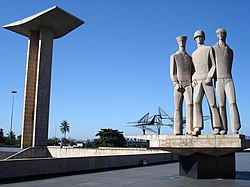Monumento Nacional aos Mortos da Segunda Guerra Mundial | |
 Concrete portal sculpture and granite statue (foreground), and metal sculpture (background), at the "Monument to the Dead of World War II" in Flamengo Park | |
 | |
| Location | Rio de Janeiro, Brazil |
|---|---|
| Coordinates | 22°55′00″S43°10′25″W / 22.91667°S 43.17361°W |
| Designer | Mark Netto Konder and Helio Ribas Marinho |
| Height | 31 metres (102 ft) |
| Completion date | 1960 |
| Designated | 1583 |
| Reference no. | 2009 |
The Monument to the Dead of World War II (Portuguese : Monumento Nacional aos Mortos da Segunda Guerra Mundial), also the Monument to the Brazilian Soldiers of World War II, popularly known as Monumento aos Pracinhas [1] [2] commemorates Brazil's participation and losses in the Second World War (WWII).
Contents
It is located in Flamengo Park (also known as Aterro do Flamengo and Parque Eduardo Gomes) on Guanabara Bay, in the Flamengo neighborhood of Rio de Janeiro, Brazil.
